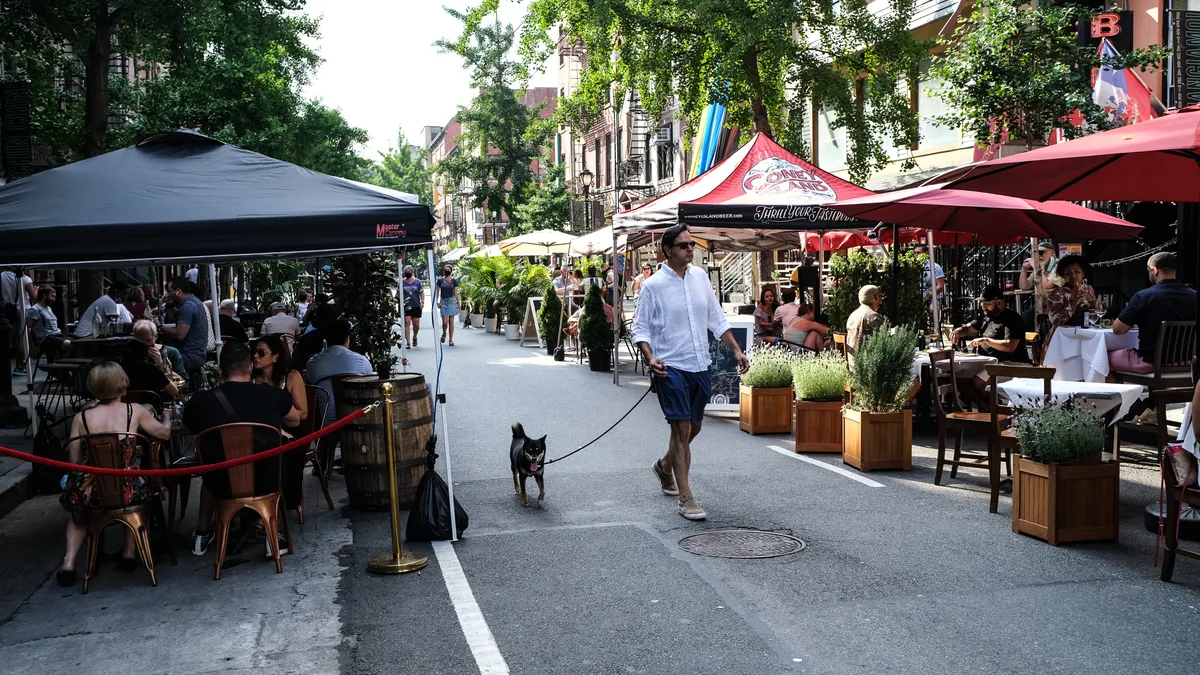Dive Brief:
- The New York City Meatpacking District Management Association, a business improvement district, recently unveiled a set of short- and long-term recommendations for the western edge of New York’s Meatpacking District.
- The recommendations aim to improve safety, mobility, and the use of public space by creating pedestrian plazas and crossings, bike lanes and green space. They aim to improve traffic patterns and, in turn, safety for cars, bicycles and pedestrians.
- The proposal follows the neighborhood’s permanent adoption of several open streets — roads closed to vehicular traffic for safe pedestrian use.
Dive Insight:
During the early months of the COVID-19 pandemic, cities and neighborhoods across the country closed off streets and roads so that pedestrians and bicyclists could better access them. The newly open areas allowed residents to safely walk with friends outside or eat at outdoor restaurant tables.
The Meatpacking District took part in that trend, joining New York’s Open Streets initiative by erecting temporary barriers to let neighborhood visitors easily walk between businesses and enjoy outdoor festivals.
When New York made Open Streets permanent, the Meatpacking District installed planters to close off city streets to create pedestrian plazas stretching six city blocks. These changes, alongside others like the Whitney Museum’s 2015 relocation to the district, have been so successful that the New York City Meatpacking District Management Association began looking for opportunities to continue to transform the neighborhood, said Jeffrey LeFrancois, executive director of the New York City Meatpacking District Management Association.
“We need to make spaces better for the neighborhood, [not only] for people who are coming here as a destination, but also for people coming to live and work here,” LeFrancois said.
In partnership with WXY architecture + urban design and Sam Schwartz Engineering, and after discussion with business owners and neighborhood block associations, the New York City Meatpacking District Management Association created its recommendations — known as the Western Gateway Vision. The plan aims to make the district safer and more enjoyable while better fitting today’s neighborhood.
Much of the Meatpacking District’s current infrastructure developed decades ago when it was a very different neighborhood, defined by the meatpackers that needed streets and loading zones designed for large trucks. While the community is now known for business and culture — such as high-end retail stores and popular bars and restaurants — increased pedestrian traffic is at odds with wide roadways, blocked sidewalks and confusing vehicular patterns.
The vision attempts to balance business and industrial demands with public needs by redesigning roadways, boosting street safety and increasing opportunities for public gatherings.
The Meatpacking District could adopt some of the plan’s recommendations relatively quickly.
LeFrancois said that one area formerly used by big trucks backing into a refrigerator building could be easily converted to a pedestrian plaza; all that’s really needed to do that is “paint and furniture,” he said.
Other parts of the plan, namely the capital improvements, will likely take years and years of work, LeFrancois said. They’ll require collaboration with — and capital from — the city and state, he added.
Even if fully enacted, the Meatpacking District will still be recognizable. “We are a historic neighborhood with a sense of place,” said LeFrancois. Any changes made to the district will “not take away [from that] — but enhance it.”











